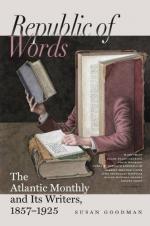Mr. Ruskin’s judgment will not be questioned by those who have seen Seddon’s pictures. But it might also be added, that such accuracy as he attained is by no means the result of mere laborious and conscientious copying, but implies and requires the possession of strong and well-balanced imagination.
We trust that the extracts we have given may lead lovers of Art to read the whole of the little volume from which they are taken.
Passages from my Autobiography. By SYDNEY, LADY MORGAN. New York: D. Appleton & Co. 1859.
Aged sportiveness is not seductive, and we do not become slaves at the tap of a fan, when the hand that holds it is palsied and withered. We have in the volume before us the melancholy spectacle of an aged female of quality setting her cap at everybody.
When an old woman makes up her mind to be young, she invariably overdoes it. The gypsy horse-dealers, when they have a particularly ancient horse to dispose of administer a nostrum to the animal, which has the effect of keeping him continually in motion, and bestowing on him a temporary vivacity which a colt would hardly exhibit. Lady Morgan is unnecessarily frisky. The gypsy’s horse, when the effect of the medicine has passed off, becomes more aged and infirm than ever. What a terrible reaction must have been the lot of this old lady, after all the capers she had cut in these passages from her autobiography!
A great, great, great, long time ago, as the story-tellers say, when novels were few and far between, and an Irish novel was a thing almost unheard of, a smart, self-educated Irish girl, of, we believe, rather humble origin, discovered that she had a knack at writing, and, having published a cleverish novel, called “The Wild Irish Girl,” was taken up by great people, exploited, made the fashion, and had Sir Charles Morgan, a physician of some standing, given her for a husband. She continued to write. Her work on France made some noise, on account of its having been prohibited by the French government; and her subsequent book on Italy, if not profound, was at least sprightly. Her Irish novels were, however, her best productions. There is considerable observation, and some feeling, displayed in them. Her knowledge of Irish society is very exact, and her pictures of it very slightly exaggerated. “The O’Briens and O’Flahertys” and “Florence MacCarthy” are, perhaps, the best of her works of fiction. At this period, Lady Morgan possessed a rather interesting appearance, great audacity, and a certain reckless style of conversation, which was found to be piquant by the jaded gossips of the metropolis. She was taken up by London society,—which must always be taking up something, whether it be a chimney-sweep that composes music, or an elephant that dances the valse a deux temps; and she fluttered from party to party, a sort of Tom Moore in petticoats,—with this difference, that Moore left his meek little wife




